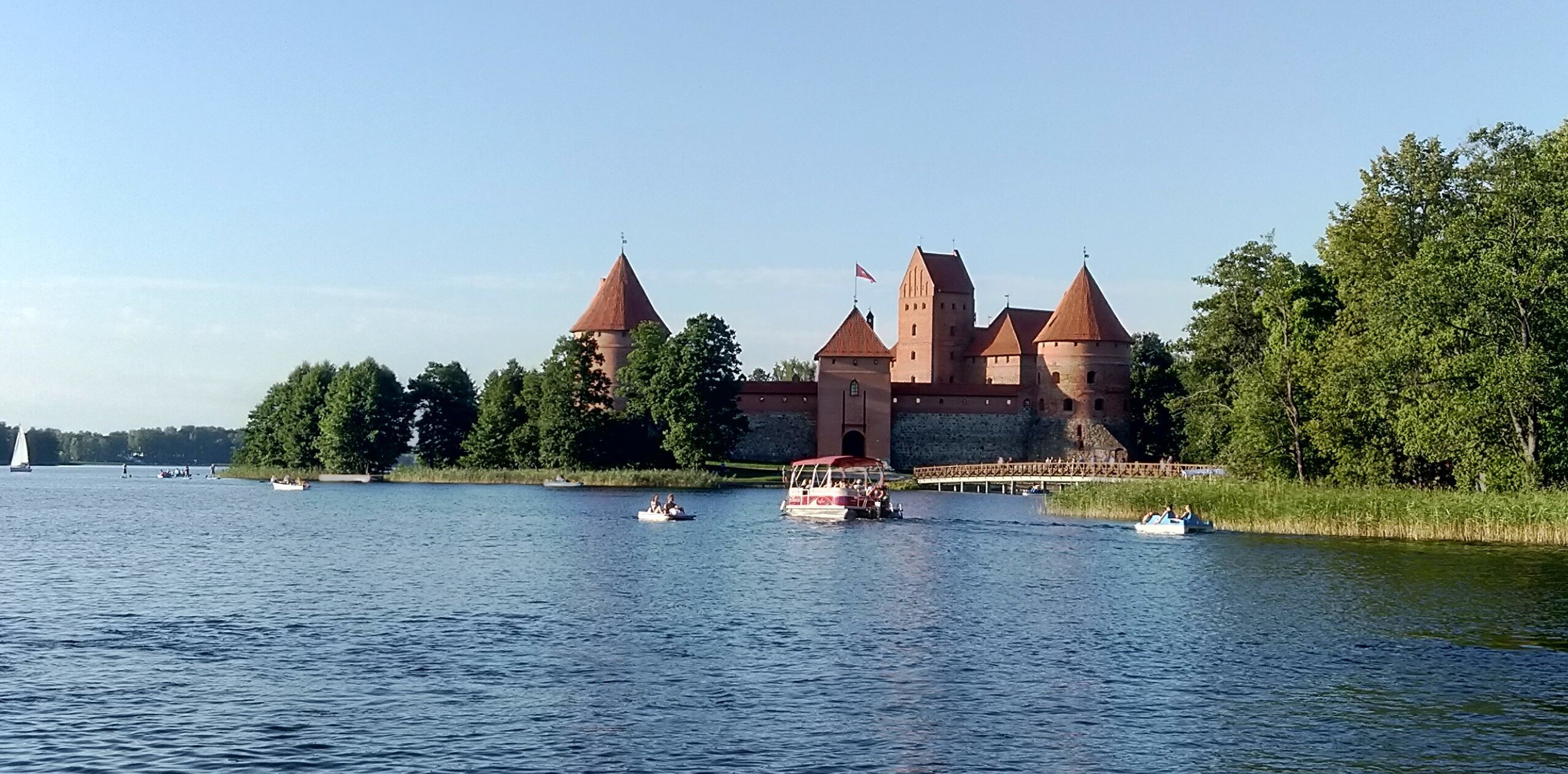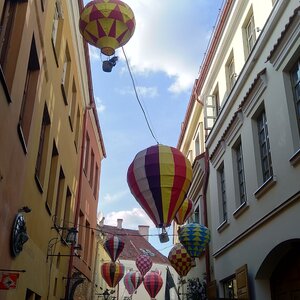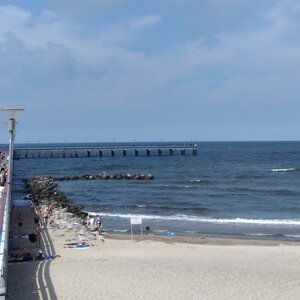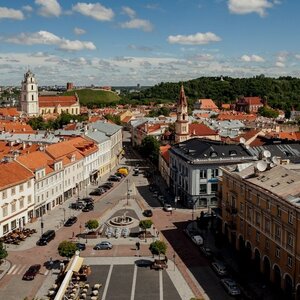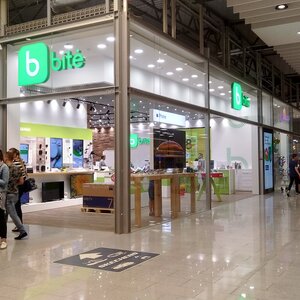Best cities near Vilnius
I will tell you about popular destinations in my homeland. Cities with a rich past and resorts will appeal to tourists of all ages, and the journey will not take long.
Trakai
There are three reasons to go to Trakai: nature, history, food. Also, the way from Vilnius to the edge of lakes and castles takes half an hour. I recommend finding a store, buying kibinai with different fillings and going straight to the castle on the island. Kibinai are patties made of thin dough. The recipe belongs to the Karaites, a people who have lived in Trakai since the 14th century.
Trakai is the second most popular city after Vilnius. Maybe the reason is that the city is not far from the capital, or maybe it is because in XIV the castle on the island became the residence of Lithuanian rulers. Then by order of Prince Gedimin five such castles were built: Lida, Novogrudok, Myadyninkai, Krevo and Trakai. But only the Trakai castle adorns social media travel blogs.
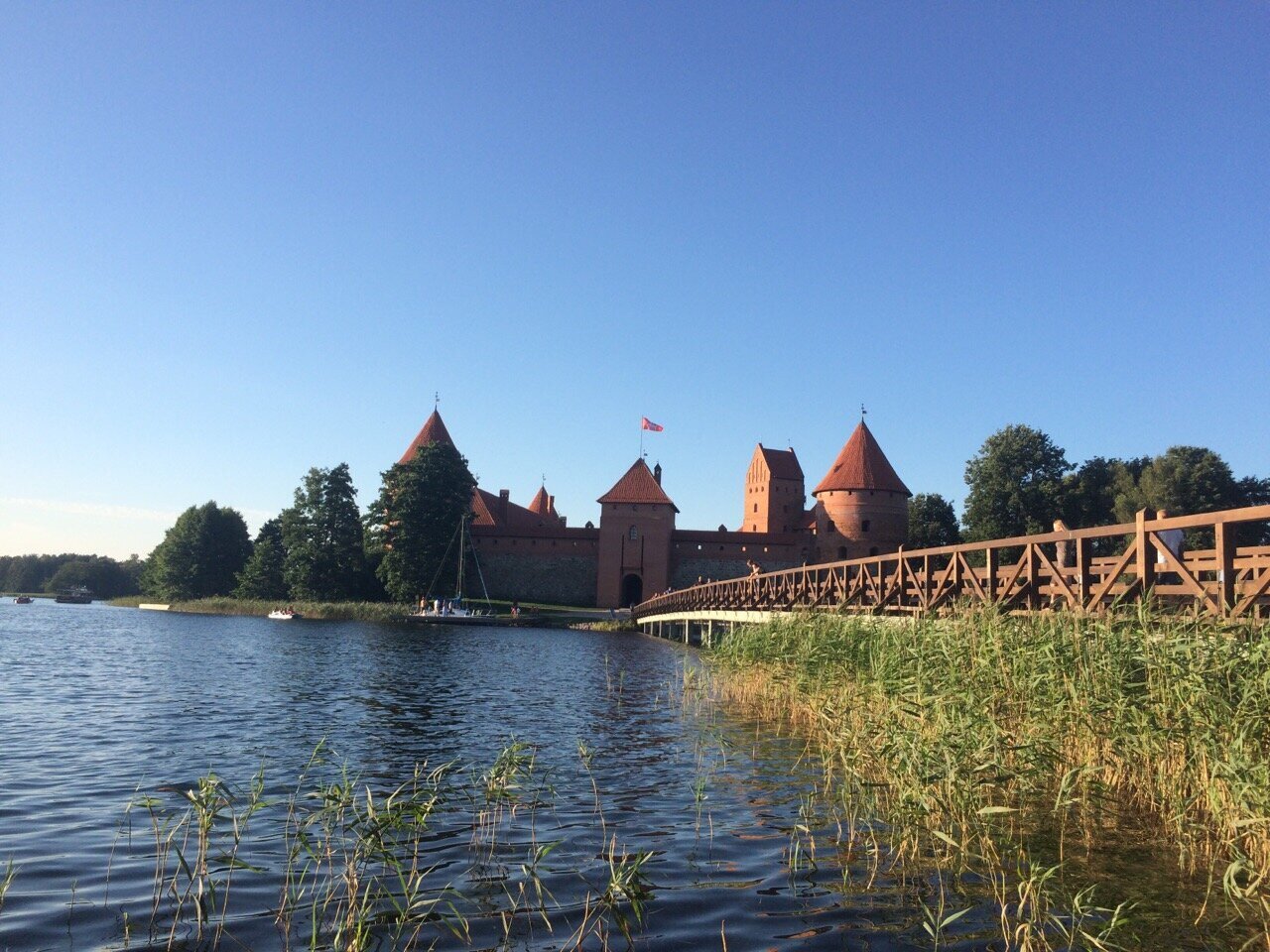
Take your time exploring the castle. From the shore, take a look at how beautiful the red brick looks in the frame surrounded by trees and sky, water and sails. For even brighter photos and impressions, you can rent a boat, sailboat or catamaran. In terms of beauty this castle is not inferior to the Polish Marienburg — they are very similar.
What else is there to see in Trakai:
- Museum in an island castle. Among the exhibits are weapons, coins, armor, dishes from knightly times, in the courtyard are instruments of torture and punishment — you can chain yourself up and take a photo for free.
- Peninsula Castle. While the island one is filled with tourists, the peninsula one is almost empty. It is ruined, but a few ancient artifacts have been preserved inside.
- Užutrakis Manor is the residence of Count Tyszkiewicz (the ones who transformed Palanga with their money). You can see the manor from the water or get there by bicycle.
- Religious architecture: Polish church, Orthodox church and kenassa of Karaites.
Finally, I suggest getting inspired by the nature of Trakai. There are 200 lakes scattered all over the region, the largest and deepest is Galve. Trakai Castle stands on one island. See how Lake Galve and the castle look from above. Sound familiar?
- How to get there: bus from Vilnius bus station (Sodų g. 22), train from the railway station (Geležinkelio g. 16). I prefer the bus — the stop is closer to the historical center of Trakai.
- Frequency: 5:30 to 23:00 every half hour. Train and bus schedule.
- Travel time: 30—35 minutes.
- Cost: bus ticket 2 €, train ticket 1,71 €. Entrance to the museum 6 €.
Kaunas
Vilnius and Kaunas, like Moscow and St. Petersburg, are the historical capitals of Lithuania. Vilnius still fulfills this role, Kaunas was the capital from 1920 to 1940. Now the city holds the honorable title of cultural and youth capital. There is a large university here and various events are constantly organized.
Kaunas is worth visiting for three reasons: culture, rich history and atmosphere. The city was built in the 14th century at the confluence of the Neman and Vilija rivers. You can see the «arrow» in the Santakos Park. Nearby is an important historical structure — Kaunas Fortress. In summer, in sunny weather, you can take a ride in a hot air balloon.
What you can see in Kaunas in a few hours:
- Vytautas Church — the first religious building in Kaunas (built in the XIV century).
- Perkunas House is a 15th century Gothic building built with money from Hanseatic merchants.
- St. Peter and Paul Cathedral is the largest religious building in Lithuania. Inside, there is a late Baroque style and a huge organ.
- Vilnius Street is the central and fully pedestrianized street of the Old Town.
- Laisves Alley is a pedestrian street connecting the Old and New Town.
- The Museum of Devils is the only collection of its kind in the world, gathered from all countries. The exhibits are accompanied by stories in several languages.
See Kaunas from above — take a cable car up Aleksotas Hill.
- How to get there: by TOKS neo bus from the main bus station, by train from the railway station. From Kaunas station (Palamonas) you will have to walk or take a bus.
- Frequency: 6 to 7 p.m. every half hour.
- Travel time: by train 1 hour 15 minutes, by bus 3 hours.
- Cost: by train 2 €, by bus 25 € one way.
Klaipėda (Klaipėda)
Klaipeda is the most un-Lithuanian city. It is not like Vilnius and Kaunas. Klaipeda has a German character. The city was founded in 1252, but not by Lithuanians, but by crusaders. The settlement was called Memel, later the Germans settled in the city.
Until 1923 Memel was part of Prussia, after the war it became part of Lithuania. The half-timbered houses and the words of an old German song «…from the Maas to Memel…» remind us of the Germanic past.
What to see in Klaipeda:
- Old Town is a compact neighborhood with German and Lithuanian architecture.
- The swing bridge at Castle Harbor — it is manually turned several times a day for people to pass, and then for ships to pass.
- The Clock Museum is a collection of wall and wrist movements, and nearby is a park with a sundial.
It is a special entertainment to find bronze figurines in Klaipeda: a mouse, a chimney sweep, a Doberman, a cat. In total, there are more than 100 miniatures in the city. What else to do in Klaipeda: 10 reasons to see the city on the Baltic Sea
In Klaipeda, try the main delicacy of the Lithuanian coast — smoked fish. It is fresh and crumbles in your hands because it has just been caught and smoked!
Klaipeda is a part of the Baltic Riviera. In summer you can visit the local Smiltines resort. Along the coast you can reach Nida and Palanga, the two main Lithuanian resorts.
- How to get there: by train or bus from the main stations in Vilnius.
- Frequency: 5:00 to 19:30 every 30 minutes.
- Travel time: approximately 4 hours.
- Cost: by train 14,50—22,10 €, by bus 22 €.
Šiauliai (Šiauliai)
People think of Šiauliai when they recommend theHill of Crosses, Lithuania’s iconic monument. It is a hill with more than 100,000 religious symbols of all sizes. One of them was placed by Pope John Paul II in 1993. It is said that if you leave a cross here (you can bring it with you or buy it in a monastery) and make a wish, it will come true.
The city has a lot to show too. Museums, streets, architecture and symbols of faith will all be interesting!
What to do in Siauliai:
- walk along Vilniaus Avenue, the first pedestrian street in the USSR;
- visit the Cathedral of Saints Peter and Paul to listen to the organ;
- go to the Bicycle Museum or the Museum of Photography;
- take a picture with the iron fox on the embankment of Lake Talksha.
This fox entered the Guinness Book of Records as the largest animalistic figure. The record was later broken by «Gorilla in the Lake», with its head half out of Lake Talksha.
In the article about edible gifts, I recommended buying Rūta chocolate. It is produced in Šiauliai, and there is a museum next to it, where they introduce the history of the factory, tell you about cocoa beans and let you make a sweet and take it home with you.
- How to get there: by bus or train from the main train stations.
- Frequency: 5:00 to 23:00 every 20 minutes.
- Travel time: train 2 hours, bus 4 hours.
- Cost: train ticket 9—19 €, bus ticket 14,20—16,20 €.
Druskininkai (Druskininkai)
A resort with healing mineral springs stands 120 km from Vilnius. It was discovered in the XVII century, the first sanatoriums were built in the XVIII century, and during the Soviet era our parents were treated here.
Druskininkai is ideal for health-improving vacations. The riverside resort is surrounded by pine forests and lakes, there are mineral springs, sanatoriums and campsites. In springs you can take water with you, in sanatoriums you can undergo health procedures.
There is never a dull moment in Druskininkai. An indoor ski slope Snow Arena and an aqua park with baths, swimming pool, diving and SPA are available all year round. The slope and the water park are located on different banks and are connected by a cable car.
Near Druskininkai Gruto Parkas — a park with dismantled monuments of the Soviet period and a contact zoo, a museum, amusement rides, cafes. The menu offers dishes a la USSR, waiters dressed like pioneers.
- How to get there: by bus from the main bus station.
- Frequency: 7:00 a.m. to 11:00 p.m. every hour.
- Travel time: 2 hours.
- Cost: 8—10 €.
What else is there to do in Lithuania? Familiarize yourself with the main cities and then get out to the first capital Kernavė, visit the observatory in Moletai, rent a boat and take a ride on the lake in Zarasai, see the forest park in Anikščiai from the height of the tree crowns, where wooden suspension bridges are spanned. And afterwards return to Vilnius and consolidate the memories of Lithuania with its delicious cuisine.
Useful links
- Search for bus or train tickets:Autobus. Travel, Busfor, Omio and Trainline
- Rent a car: Rentalcars, Economybookings and AutoEurope
- Searching for a traveling companion:Blablacar.

